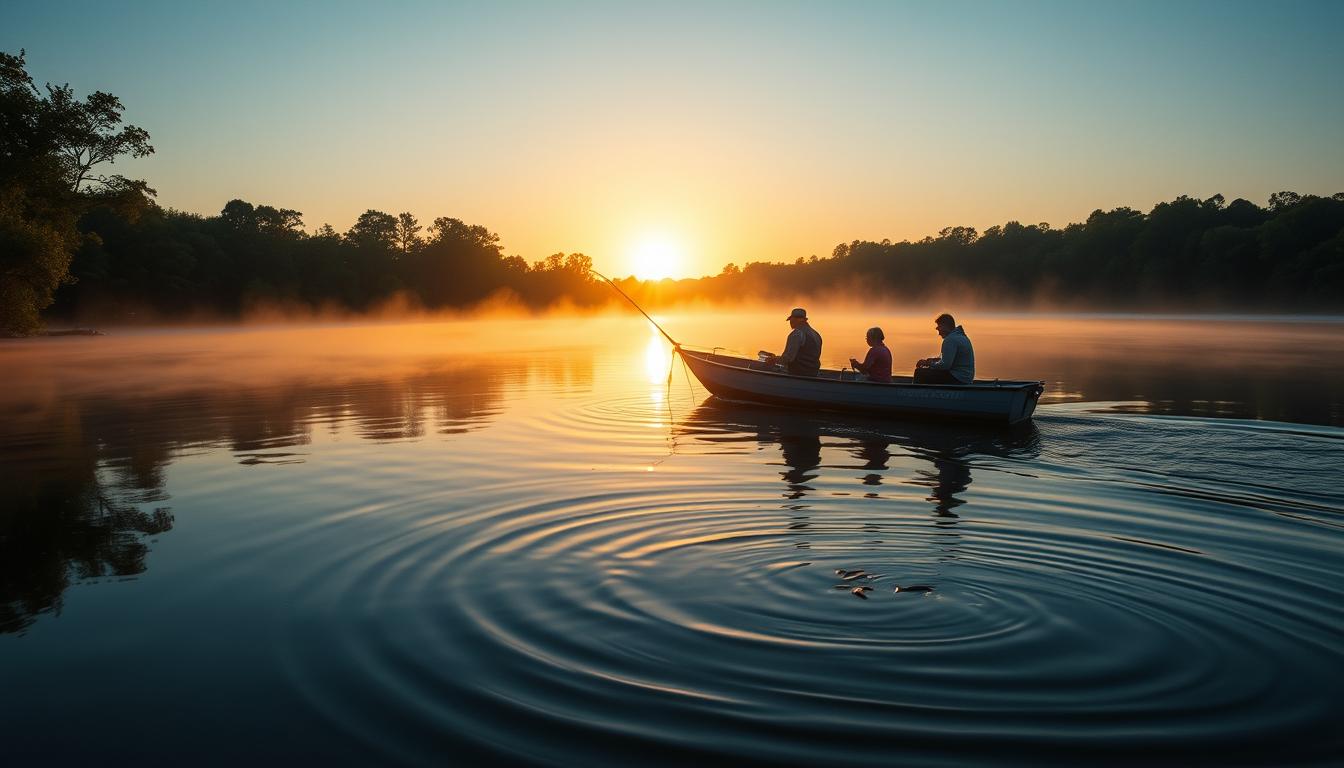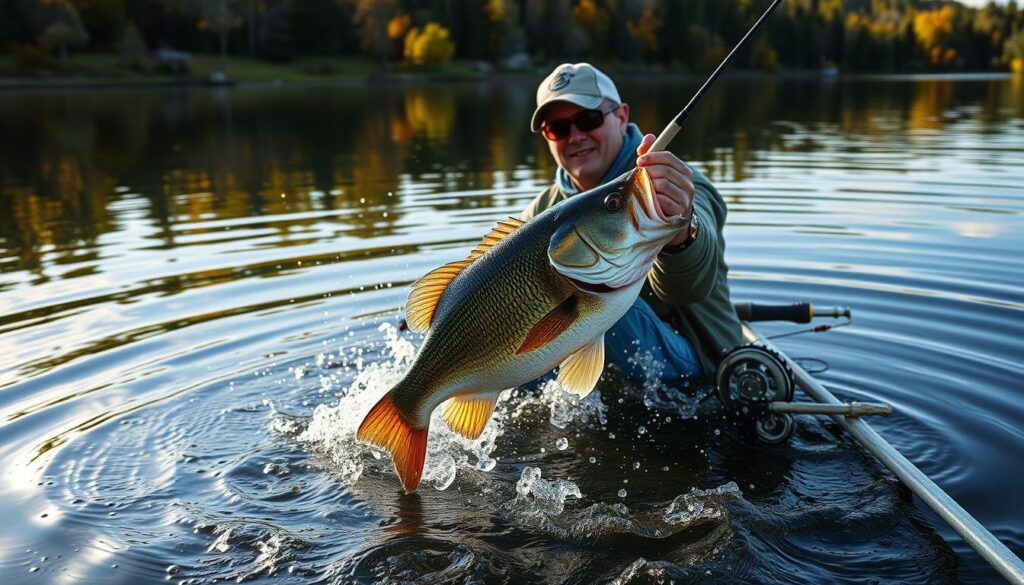Physical Address
304 North Cardinal St.
Dorchester Center, MA 02124
Physical Address
304 North Cardinal St.
Dorchester Center, MA 02124

Largemouth bass have won the hearts of many anglers in the United States. They have moved from being a food source to a favorite sport. Families come to the water’s edge all year to enjoy the thrill of bass fishing.
The history of bass fishing in America is fascinating. It started with early settlers and has grown into a huge industry. Today, it’s a billion-dollar sport, loved by millions for its excitement and challenge.
Bass fishing in America started in the 1700s. It was not a sport back then but a way for settlers to get food. They used tools like natural cordage and nets to catch fish.
The multi-gear reel’s arrival in the late 1700s was a big step. It led to more improvements in fishing gear. In the late 1800s, William Shakespeare Jr. made a level wind system for reels. This was a major change for sport fishing.
In the colonial era, bass fishing was for food. People used old methods to catch fish like bass and catfish. They used natural materials and simple tools to meet their needs.
Over two centuries, bass fishing changed a lot. It went from a way to get food to a fun activity. The multi-gear reel was a key invention in the late 1700s. Later, William Shakespeare Jr.’s level wind system made reels better for sport fishing.
In the early 1900s, new lures like stick baits came out. This was the start of today’s fishing tackle. In the 1930s, DuPont made nylon nets, leading to monofilament line, a favorite among anglers.
| Year | Fishing Gear Innovation |
|---|---|
| Late 18th Century | Introduction of the multi-gear reel |
| Late 1800s | William Shakespeare Jr.’s level wind system for spinning reels |
| Early 1900s | Development of modern lures, such as stick baits and hard-bodied lures |
| 1930s | Invention of nylon fishing nets by DuPont, leading to monofilament fishing line |
In the late 1800s, fishing was mainly for food. But, the early 1900s saw a big change. A remarkable event in 1932 changed everything. George Perry caught a huge 22-pound, 4-ounce largemouth bass while fishing after work.
This catch made headlines and inspired many. It turned bass fishing into a fun recreational pastime. This shift marked the start of recreational bass fishing in America.
George Perry’s record-breaking catch is legendary in sport fishing. On June 2, 1932, he caught a fish that broke all records. This fishing record impact made many anglers want to break his record.
Perry’s catch in Montgomery Lake, Georgia, was the world record for 80 years. It showed how big his achievement was. This moment changed bass fishing from a need to a fishing thrill-seeking and fishing as pastime.
“The George Perry catch that sparked interest in recreational bass fishing has become a legendary moment in the history of the sport.”
The early 1900s were a time of big changes in bass fishing. New lures and equipment made the sport better. The Wiggle Worm, made in 1949 by Nick Creme, was a big hit. It was shown at a sports show and sold over 9,600 packs for $1 each.
The Texas rig technique made Creme worms even more popular. These new ideas helped sport fishing grow. Lures like the fishing spoon, made by Julio T. Buel in 1834, and the Original Floating Rapala, created by Lauri Rapala in 1936, were also important.
The Mepps Aglia, made by Andre Meulnart in 1938, became a favorite spinner lure. By 1960, it sold over half a million in the US. These changes in fishing lure evolution and modern lure development set the stage for the golden age of bass fishing in the 1950s and 1960s.
In 1938, DuPont invented nylon fishing nets, leading to monofilament fishing line. This change made fishing better and became the top choice for anglers today. The nylon fishing line invention and ongoing tackle technology progress shaped bass fishing’s future.
“A Lure Fish Can’t Pass Up” – Life magazine article, 1962
The improvements in lures and equipment, along with bass fishing’s growing popularity, set the stage for the sport’s future success.
When the 20th century started, fishing became a favorite hobby in America. George Perry’s record-breaking bass catch in 1932 made people excited about bass fishing. The post-depression economic boom let more people enjoy fishing as a fun activity.
In the early 1900s, fishing was mostly for food. But soon, the thrill of catching a big fish became more important. Anglers started focusing on catching trophy-sized bass, leading to more bass record keeping.
The 1950s and 1960s were the “golden age” of bass fishing. This time saw a big increase in recreational fishing. New inventions like the soft-plastic worm in 1949 made fishing even more exciting.
The big bass catches of this era helped grow the In-Fisherman’s Master Angler Awards. This program has honored amazing catches for nearly 50 years. Today, bass fishing is a favorite family activity that still excites many.
Bass fishing is a favorite outdoor activity in America. It’s loved for being easy to start, available all year, and fun for all ages. Families can make memories by catching bass, whether it’s a big largemouth or a smallmouth.
The excitement comes from catching fish that can weigh a few pounds to over 20 pounds. Largemouth bass are especially popular. They can be found in almost every freshwater spot, making bass fishing a year-round activity for everyone.
For generations, families have enjoyed bass fishing together. It’s a way for young and old to bond over the water. From learning to cast to perfecting skills, bass fishing brings families together.
Bass fishing is also easy to get into because of its wide availability. Lakes, rivers, and reservoirs offer plenty of spots for fishing. It’s a sport that welcomes everyone, making it a favorite for many.
Bass fishing’s lasting appeal comes from the thrill of catching them and the tradition it brings. As people keep fishing for these iconic fish, bass fishing will keep families and communities connected for years.
“There’s nothing quite like the rush of setting the hook on a big bass. It’s a feeling that never gets old, no matter how many times you experience it.” – Jim Duckworth, avid bass angler
For avid anglers, the thrill of catching a trophy largemouth bass is unmatched. The challenge of catching large bass and setting a personal best is what drives them. They seek their next angling challenge and adrenaline rush.
The excitement of the hook-up and the fight with a powerful fish is what anglers love. They are amazed by the fish’s strength and fighting spirit. Anglers use many tactics to outsmart and catch these impressive fish.
| Key Fishing Statistics | Value |
|---|---|
| Fishing is a popular pastime worldwide | – |
| Spending time near water can reduce stress levels instantly | – |
| Fishing can reduce cortisol levels, the hormone associated with stress | – |
| Engaging in fishing can improve strength, endurance, and cardiovascular health | – |
“The thrill of the catch is what keeps me coming back to the water, time and time again. There’s nothing quite like the heart-pounding excitement of wrestling with a trophy bass and finally getting it in the boat.” – John Doe, avid bass angler
The anticipation of the strike, the fight, and the joy of catching a personal best are key. These moments capture the hearts and minds of passionate anglers in the United States.

We love bass fishing and know it’s vital to protect our fish friends. The “Catch, Photograph, and Release” (CPR) method is key. It lets us enjoy fishing while making sure the fish are safe to swim again. Handling fish right is crucial to keep them healthy and able to grow and have babies.
These steps help keep bass populations strong for future anglers. By following bass fishing conservation and ethical angling practices, we keep fishing alive and fun for everyone.
The CPR method is popular among responsible anglers. It means catching the fish, photographing it, and then releasing it back into the water. By handling fish carefully, we help them stay healthy and play their part in keeping bass populations thriving.
“Catch, Photograph, and Release – it’s not just a slogan, it’s a way of life for the true bass fishing enthusiast.” – Lefty Kreh, Fly Fishing Contributor
By sticking to catch and release, we make sure bass fishing stays a beloved activity for years to come.
| Best Practices for CPR | Benefits |
|---|---|
|
|
Bass fishing is now a top choice for many in the United States. Largemouth bass can be found in freshwater everywhere, making it easy to fish year-round. It’s fun and diverse, attracting both new and seasoned anglers.
The sport is easy to start with, which has boosted its popularity. Unlike some fishing, bass fishing doesn’t need special skills or gear. This makes it perfect for beginners and families, helping it grow in popularity.
Bass fishing is loved because it’s available almost everywhere. You can fish in lakes, rivers, reservoirs, and ponds. This makes it easy for people to find a place to fish near home. It has created a strong bass fishing community across the country.
The mix of easy access, constant fishing chances, and the excitement of catching bass has made it a favorite. As more people try it, bass fishing will likely keep growing. It’s becoming a fun activity for people of all ages and skill levels.
Bass fishing is loved by people of all ages, making it a great way for families to bond. It’s enjoyed by kids and grandparents alike, offering a chance for everyone to spend time outdoors together. This activity helps families grow closer and pass down important traditions.
The Intergenerational Project “The Power’s in the Word” is a great example. It was a 12-week program in Kingston that brought together people of different ages. They did things like printmaking, poetry, and storytelling together. This helped everyone learn from each other and try new things.
Fishing with family is more than just a hobby. It’s a way to make memories and strengthen family ties. Working together to catch a big bass and sharing fishing stories can create lasting bonds between family members. It brings everyone together, making them feel like they’re part of something bigger than themselves.
“The workshops included activities like creating collographs, monoprints, and writing pieces inspired by visual art. The session involved various tasks aimed at encouraging creative expression, skill development, and collaboration among participants of different age groups.”
More and more families want to travel together, and bass fishing is a big part of that. The 2024 Virtuoso travel trends show families looking for places that everyone can enjoy. Places like Amsterdam, Cape Town, and the Galapagos Islands are popular for their outdoor activities, including fishing.
In short, bass fishing is special because it brings families together, no matter their age. It’s a tradition that creates lasting memories and strengthens family bonds. By sharing the joy of fishing, families can grow closer and create a stronger community.
Bass fishing is more than just a sport; it’s a journey to mental and social health. Being in nature and focusing on fishing can make you more mindful and reduce stress. It also helps you connect with others, whether it’s with friends, family, or in fishing clubs.
Research shows that fishing can boost your mood and mental health. It gives you a break from daily life and lets you enjoy nature. Fishing helps you stay present, which can lower stress and improve your mental state.
Fishing also builds strong social bonds. Anglers form close communities around their love for fishing. These connections offer a sense of belonging and support, enhancing overall well-being.
| Location | Current Conditions | Fishing Recommendations |
|---|---|---|
| Lake Lanier | Water level at 0.64 feet above full pool, water temperature in the upper 70s | Topwater baits most productive, target depths of 25-35 feet, use different color variations based on weather |
| Lay Lake | Known for large largemouth and Coosa spotted bass, fertile lake with common tournament limits around 20 pounds | Effective baits include swim jigs, bladed jigs, spinnerbaits, crankbaits, and drop shot worms |
Bass fishing is a rewarding activity that benefits both mind and heart. It connects you with nature, builds friendships, and improves your overall well-being. Bass fishing offers a complete experience that goes beyond just catching fish.

We have a big responsibility as passionate anglers. We must introduce the next generation to bass fishing. This way, we keep the tradition of youth fishing education alive for years.
Teaching young anglers how to fish gives us a chance to share important life lessons from fishing. Casting, reeling, and catching a bass teaches patience and problem-solving. These skills are crucial for life.
Being on the water also teaches kids to love and respect nature. This outdoor recreation for kids is fun and teaches them to care for the environment. It’s a great way to start a lifelong love for nature.
By teaching the next generation anglers about bass fishing, we help keep this sport alive. We share the excitement of catching fish and the peace of being outdoors. It’s a way to pass on valuable lessons and traditions.
Bass fishing has created a lively culture of events and celebrations. These events bring anglers together. They offer chances to show off skills, compare catches, and enjoy the sport’s excitement.
Community events like National Hunting and Fishing Day are great for newcomers. They let anglers share their love for bass fishing. These events include casting demos, fishing clinics, and fun for families, building a sense of community.
Bass fishing tournaments are a big deal across the country. They attract both spectators and competitors. These tournaments range from small local ones to big national and international ones, offering a chance to win big.
The excitement of bass fishing tournaments shows how much people love the sport. Anglers look forward to these events all year. They plan and practice to catch the biggest fish and win.
| Event | Description | Location | Date |
|---|---|---|---|
| Bassmaster Classic | The most prestigious bass fishing tournament in the world | Various locations | Annually in February or March |
| MLF Bass Pro Tour | A high-level professional bass fishing tour with events across the United States | Multiple venues | Throughout the year |
| National Hunting and Fishing Day | A celebration of outdoor recreation and conservation efforts | Nationwide | Fourth Saturday in September |
Bass fishing is more than just a hobby; it’s a way to connect with others. It celebrates America’s rich angling traditions. Whether it’s the thrill of competition or the joy of community events, bass fishing is a cherished activity.
Anglers dream of a future where bass fishing is transformed by technology. They imagine self-driving boats and advanced glasses for precise casting. The gear of tomorrow will likely be much different from today’s.
Technological advancements are set to change bass fishing. Expect better boats and navigation systems for easier waterway exploration. Smart glasses could improve casting accuracy, and automated tools might help with fishing tasks.
But, bass fishing’s future is not without challenges. Anti-hunting groups could limit outdoor access, affecting the sport. Anglers must adapt to these changes while keeping the sport’s heritage alive.
“The future of bass fishing will be shaped by our ability to embrace technological innovations while preserving the essence of the sport.”
Anglers must balance new tech with tradition to keep bass fishing exciting. This way, the thrill of catching bass will continue to delight future generations.
Bass fishing has grown from a basic need in colonial times to a favorite family activity. It attracts people of all ages with its excitement and new technologies. As bass fishing evolves, we’ll see new ways to enjoy it, while keeping its traditions alive.
Passing on the love for bass fishing to younger generations is key. It keeps the sport exciting and connects families to nature. Despite challenges like fewer young bass and fishing impacts, its appeal shows its lasting value in America.
It’s important for anglers, conservationists, and leaders to team up. They must find ways to keep bass healthy and protect the sport’s traditions. This way, bass fishing will remain a cherished part of the American outdoors for years to come.